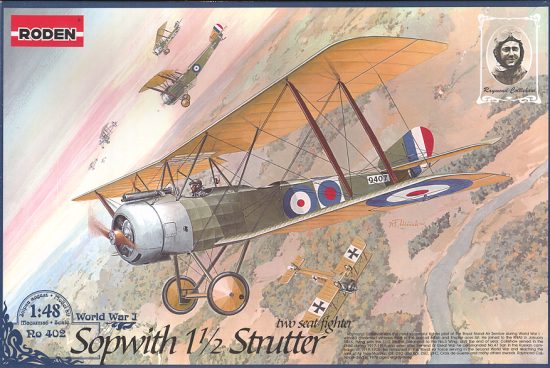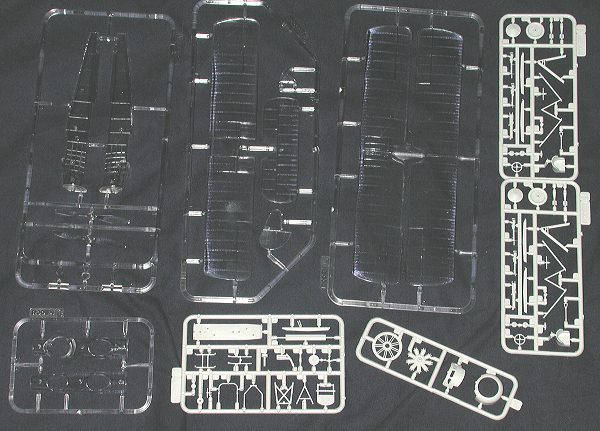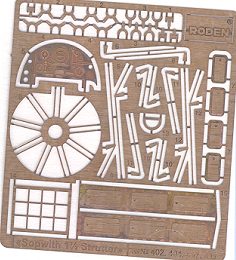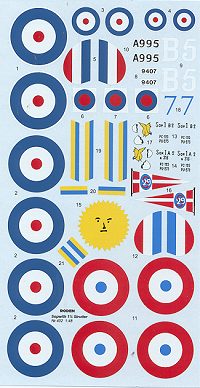
|
KIT: |
Roden 1/48 Sopwith 1 1/2 Strutter 2 seat fighter |
|
KIT # |
402 |
|
PRICE: |
$23.98 ($20.96 at Squadron) |
|
DECALS: |
4 aircraft |
|
REVIEWER: |
|
|
NOTES: |

|
HISTORY |
The Sopwith Strutter has earned its place in history as the first Allied aircraft with a synchronized forward firing machine gun. It also was a tractor engined aircraft, something that was not the norm with pushers being considered the way to go with fighters. Of course, this change came about because of the synchronized gun which meant that it could fire through the prop arc and allowed the now-standard layout of the aircraft.
Initial flight testing started in late 1915 and the distinctive W cabane struts lead to it being called the '1 1/2 Strutter as the W struts looked like a full set and a half. The initial planes went to the RNAS (Navy) and they were quite pleased with its performance. Though there were times when no forward gun was carried (I guess they thought the rear gunner was enough), the forward gun was quite a boon. Additionally, sometimes the rear gunner and gun were not carried making it, in effect, a single-seat fighter.
Anyway, in what seems like an odd juxtaposition of roles, the two seat planes were developed as fighters and the single seat ones were built as bombers. A huge order for planes was placed with Sopwith who were completely unable to handle the construction of that many planes so Strutters were built by a number of other companies with nearly 1,300 eventually being built. A number of them were sold to France who had real need of aircraft at this time and eventually built nearly 4,500 of them under license. Other countries to get the Strutter, many of them post war, were Latvia, Russia, Belgium, Japan, and Greece. The US bought over 500 of them from France to use as trainers.
However, the pace of technology was such that a year later in 1917, they were woefully obsolete themselves and though the Brits removed from front line service, the French kept them in action until near the end of the war. Many survived into the 20s in various guises with either air forces or as civil aircraft.
|
THE KIT |

Upon opening the box, I was quite surprised to see that most of
the airframe was in clear plastic! perhaps this to help add to the rather
diaphanous feel of early planes or to make it easy to have the clear part on the
upper wing. Whatever the reason, it will make for some interesting construction.
For sure it will mean that the parts will have to be carefully handled
 as clear plastic is notoriously
brittle. I found no sink marks, ejector pin marks or other blemishes in the
clear bits. The fabric surface looks rather pronounced, but that is due to the
clear plastic as much as anything else and it feels pretty smooth.
as clear plastic is notoriously
brittle. I found no sink marks, ejector pin marks or other blemishes in the
clear bits. The fabric surface looks rather pronounced, but that is due to the
clear plastic as much as anything else and it feels pretty smooth.
The rest of the parts are very well molded with crisp detail and only a hint of flash on a few bits. The attachment points are a small, but close to the parts in many cases. I suggest a razor saw for the thin bits to keep from snapping them. As with most Roden kits of late, almost all the parts for this kit are identical to the single-seat bomber also released at this time. The only difference is the upper cockpit section which, for this kit, is a two-holer.
There is an etched metal fret included that offers a number of small detail parts. It is quite well done and hints at a total of four Strutter kits. Undoubtedly the second cockpit insert that is not used on this kit will be for one of those others. There are a few etched metal parts not used on this kit as well.
 Instructions
are first rate given clear, concise construction drawings. Oddly, the attachment
of the metal bits is treated as a totally separate set of construction
sequences. So in effect you have multiple step 1, 2, 3, etc. I can only gather
that the kit can be built without using any of the etched metal parts so the
builder needs to make a judgment as to what, exactly, will be used and modify
his build steps to accommodate his decision. A full rigging diagram is also
given.
Instructions
are first rate given clear, concise construction drawings. Oddly, the attachment
of the metal bits is treated as a totally separate set of construction
sequences. So in effect you have multiple step 1, 2, 3, etc. I can only gather
that the kit can be built without using any of the etched metal parts so the
builder needs to make a judgment as to what, exactly, will be used and modify
his build steps to accommodate his decision. A full rigging diagram is also
given.
Colors are given as both generic colors and as Humbrol paint numbers. The decal sheet for this kit is very colorful and provides for two British and two French planes. The French aircraft are the ones with all the color! The two Brit planes are the box top aircraft from 3 Wing RNAS and flown by ace Robert Coltishaw. The other British aircraft is from 70 Sq RFC. These planes are painted matte green upper and 'linen' lower surfaces. The two French planes are quite distinctive and are overall linen in color. The first is from Esc 29 and the other from Esc 227 in 1917. The decals are super and very well printed. They should pose no problems with application other than being very thin.
|
CONCLUSIONS |
If you are into WWI, then you should seriously consider this kit. The price is right and it looks to be an excellent build. There will be a full build review in a few weeks so stay tuned!!
You can find this kit and many others at

If you would like your product reviewed fairly and fairly quickly by a site that has well over 150,000 visitors a month, please contact me or see other details in the Note to Contributors.
Back to the Previews Index Page